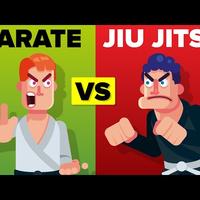Karate vs Brazilian Jiu Jitsu - Which Martial Arts Is Better?
It's a question popular in internet forums- often amongst keyboard warriors with no actual
mat experience: which is the better martial art, Karate or Brazilian Jiu Jitsu?
Despite the countless opinions given online, the real answer is not that easy to ascertain.
First though, let's learn a little bit more about each martial arts style.
Brazilian Jiu Jitsu has its origins, naturally enough, in Brazil.
Back in the turn of the 20th century, the founder of Judo, Kano Jigoro, sent five of
his best students overseas to demonstrate the art of judo.
Amongst these five was Mitsuyo Maeda, a man often considered the first mixed martial artist
of the modern era.
Maeda traveled the world and gave demonstrations at every country he came to, fighting against
wrestlers, boxers, savate fighters, and various other martial artists.
In 1917, Maeda was in Brazil when a young man by the name of Carlos Gracie happened
to be in the audience during one of Maeda's demonstrations.
Eager to be trained in the art of Judo, Carlos Gracie asked Maeda after the demonstration
to take him on as a student, to which Maeda agreed.
Carlos would go on to train with Maeda for several years, before Maeda moved on and Carlos
opened up his own judo school to train others.
Carlos' other siblings had learned Judo along with him, and helped him teach classes to
new students.
Only one brother was unable to join in their Judo practice, younger brother Helio Gracie
who was far physically weaker than his brothers and thus unable to muster the strength to
stand toe to toe with other fighters.
Instead, Helio began to modify the techniques his brothers used, eventually developing a
fighting style which was both simpler, and sought to avoid the stand-up fighting style
of most martial arts.
Helio's new combat style would prove revolutionary.
With this new style, the much smaller Helio was able to defeat his larger brothers, and
soon he was taking on other fighters.
By using leverage techniques, Helio was able to take much larger opponents down to the
ground, and then use superior groundwork techniques to force his opponents into painful submissions.
With a focus on bringing the fight to the ground, Helio had avoided the need for raw
physical strength to stand toe-to-toe with a poweful striking foe.
His technique was so effective, he was soon challenging and winning matches against men
as much as eighty pounds larger than him.
With a focus on ground techniques, torsions, and submissions, Brazilian Jiu Jitsu is a
simple yet extremely effective fighting technique that can see small fighters defeat far larger
opponents.
It's emphasis on simplicity allows fighters to focus on learning a smaller number of techniques
and thus master them, as opposed to the much greater range of techniques of traditional
Jiu Jitsu.
The exact origins of Karate are shrouded in mystery.
Some believe that Karate was created by wandering Indian monks who developed the fighting style
as a means to defend themselves without weapons.
Others believe that it was natively developed by the inhabitants of the Ryukyu Kingdom,
an island kingdom that ruled the Japanese Ryukyu islands from the 15th century to the
19th century.
What is known is that the martial art that would become known as Karate came to prominence
in the Ryukyu Kingdom, and adapted from Chinese Kung Fu.
In 1879 the Empire of Japan annexed the Ryukyu Kingdom, and Ryukyuans brought the martial
art with them to the mainland as they migrated in search of work.
The martial art gradually grew in popularity, but became a national sensation after the
Japanese Ministry of Education invited Gichin Funakoshi, the father of modern karate, to
give a demonstration in Tokyo.
Two years later in 1924, karate clubs began to appear in major universities, and by 1932
nearly every large japanese university had a karate club.
The martial art would become an international sensation though thanks to the American occupation
of Okinawa island after the end of the second world war.
American servicemen were exposed to the martial art form, and brought much of the knowledge
back home with them.
A growing interest in the martial art quickly saw Japanese instructors moving to America
and beyond, making Karate a global martial art form.
In the 1960s and 1970s, martial arts movies greatly added to karate's popularity, and
today it's one of the most widely practiced martial arts.
Unlike Brazilian Jiu Jitsu, karate largely focuses on the striking power of the hands
and feet, though any body part can be utilized as a striking weapon if need be, to include
the head.
After coming in contact with other martial arts, karate quickly adopted the use of grappling,
throwing, and securing opponents in joint locks, though karate is still best utilized
as a stand-up fighting style.
So of the two, which is better- karate or brazilian jiu jitsu?
Brazilian Jiu Jitsu may not have the emphasis on striking that karate does, but that doesn't
mean that its practitioners don't know how to throw a punch.
Just the opposite, BJJ often utilizes strikes in order to subdue opponents who have been
successfully grappled, or to try and defend from being grappled.
Karate however is almost the inverse of BJJ, with a much greater focus on striking power
from a standing position, avoiding a ground fight if at all possible.
In a fight a BJJ fighter will try to move the fight to the ground as quickly as possible,
in order to neutralize the striking power of an enemy fighter.
On the ground, a fighter isn't able to generate nearly as much power in a punch or a kick,
while in the standing position trained fighters are able to transfer power from their legs,
up through their hips, to their fist- essentially turning a single punch into a full-body power
blow.
By moving to the ground, not only is the amount of power generated for a punch or a kick dramatically
lowered, but vital KO sites on the body are much easier protected.
Good guard techniques and smart placement of your opponent can keep dangerous KO sites
on the body- such as behind the ear on the head- protected against an enemy's strikes.
Standing up though, even a successfully blocked blow to such a site can still at times transfer
enough energy to still be a threat.
On the ground, a BJJ fighter will quickly move into a position where they can leverage
much of their body weight against select areas of the opponent's body, especially the limbs
in what is known as an arm or leg lock.
In the classic straight angle lock, an opponent's foot is captured and held against the ribs,
and then the BJJ fighter can roll and use strength from their chest, back, and arms
to apply incredible force to the foot, breaking it if the opponent does not submit.
Many BJJ techniques focus on applying extreme force to vulnerable body parts, and is why
Brazilian Jiu Jitsu allows even much smaller fighters to defeat heavyweight opponents.
Karate on the other hand focuses on keeping the fight as upright as possible, seeking
to end a fight by delivering a brutally powerful blow to an opponent's KO site or by devastating
an opponent's limbs.
Rather than using torsion to force a submission, or physically incapacitate a foe, karate uses
techniques such as the devastating elbow strike to deliver incredible power to a very precise
point on the opponent's body.
An elbow strike to the solar plexus can end a fight, while an elbow strike to an opponent's
own extended elbow can severely damage the joint and make the arm useless.
A major focus on karate is also the execution of devastating combo attacks meant to catch
your opponent completely off guard.
One prime example of this is the low kick/high kick combo, in which a karate fighter will
launch a quick series of low kicks at his opponent's legs, and when the opponent drops
their guard to protect against another expected low kick, the karate fighter then uses the
opportunity to launch a crushing high kick against the opponent's head or open torso.
Understanding an opponent's positioning and having a natural ability to know how they
are supporting their weight is vital to karate's success, as it often relies on predicting
an opponent's physical movements or striking at the supporting leg to drop an opponent
to the ground.
Once on the ground, the karate fighter can finish an opponent off with devastating kicks
or punches.
This is not to say that karate does not involve ground work.
Very quickly karate practitioners realized that they needed to be proficient in ground-and-pound
techniques as well as striking, and thus karate still includes some joint locks and submission
techniques, though without the extreme focus of brazilian jiu jitsu on ground work.
So, which is better?
The answer is unfortunately, one of pure circumstance, though for us personally, Brazilian Jiu Jitsu
has slightly more appeal than traditional karate.
BJJ's focus on closing the distance between yourself and an opponent and bringing the
fight to the ground, immediately negates many of the most devastating striking techniques
that exist in any martial arts form, and nullifies a large portion of the opponent's strength
as they are no longer able to wind up full-body power punches or kicks.
It also limits the opportunities for you to inadvertently hurt yourself by throwing a
poorly executed punch or kick which could lead to a broken hand or foot.
Karate however provides a great number of opportunities to finish a foe off before they
get close enough to cause serious damage, and its focus on guards against strikes will
give you the tools you need to limit the punishment you take from a powerful striker.
Sometimes circumstances simply won't allow you to drop an opponent to the ground and
overpower them through superior technique- like if for instance you are fighting in a
very small space.
Karate also encourages a fighter to remain mobile, which can be critical for fighting
multiple opponents.
BJJ on the other hand has an almost myopic focus on fighting a single opponent at a time,
and is one of the worst martial arts forms for defending yourself from multiple attackers.
The advantage that Brazilian Jiu Jitsu provides on the ground though simply can't be ignored,
and there's a reason why small fighters can successfully defeat even heavyweights using
the technique- something that karate doesn't so easily allow.
In the end, which martial art is better comes down to circumstance and personal preference-
though for us personally, we prefer the ability to move a fight to the ground where we can
better defend against strikes and quickly force an opponent into submission or simply
incapacitate them by destroying their limbs.
Alright there Bruce Lee, now that you've made it through the video and before you start
yelling at us in the comments, why not check out one of our other great videos like this
one here, or if that one doesn't do it for you, why not check this one out instead?
We promise both are great, so don't wait and click now!

